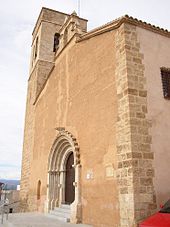Llíria
| Llíria | ||
|---|---|---|
 Historic town hall, former palace of the Dukes of Liria
|
||
| coat of arms | Map of Spain | |

|
|
|
| Basic data | ||
| Autonomous Community : | Valencia | |
| Province : | Valencia | |
| Comarca : | Camp del Túria | |
| Coordinates | 39 ° 38 ′ N , 0 ° 36 ′ W | |
| Height : | 164 msnm | |
| Area : | 227.98 km² | |
| Residents : | 23,253 (Jan. 1, 2019) | |
| Population density : | 102 inhabitants / km² | |
| Founding: | Iberians ; 5 v. Chr. | |
| Postal code : | 46160 | |
| Municipality number ( INE ): | 46147 | |
| Nearest airport : | Valencia-Manises Airport | |
| administration | ||
| Official language : | Castilian , Valencian | |
| Mayor : | Manuel Izquierdo Igual ( PP ) | |
| Website : | www.lliria.es | |
Llíria ( Valencian and official; Castilian : Liria ) is a city in the Valencian Community in Spain. Llíria is also the capital of the Comarca of Camp del Túria.
economy
Llíria's economy has transformed in the last few decades from a traditional economic structure (rain-fed agriculture, local craftsmanship) to a modern one (irrigated agriculture, industrialization, tertiary sector). Industrial activity (27.1% of the labor force) has developed particularly in the last few decades and has an established endogenous component as it evolved from traditional handicrafts. The most important branch of the economy is industrial production, followed by building materials, furniture and tourism.
Culture and sights
Theaters and museums
- Banda Primitiva Theater
- Union Musical Theater
- Archaeological Museum of Liria
- Silvestre de Edeta Museum
Buildings
- Roman mausoleums - "Mausoleos romanos"
- Mura sanctuary and Roman baths - "Santuario y termas romanas de Mura"
- Church of the Blood - "Iglesia de la Sangre": The church was built in the thirteenth century on an old mosque; it combines Romanesque with Gothic elements. The church was declared a National Historic Monument in 1919 and is now classified as a Bien de Interés Cultural .
- Royal Monastery of Saint Michael - "Real Monasterio de San Miguel": The monastery was founded by King Jaime II in 1326, and was reformed in 1406 by King Martin I. The current building in neoclassical style dates from 1774.
- Church of Our Lady of the Assumption - “Iglesia de Nuestra Señora de la Asuncion”: Baroque church from the seventeenth century
- Hermitage of Saint Vincent - "Ermita de San Vicente": The current building was built in memory of a miracle attributed to Saint Vincent. According to tradition, he had water brought out of a well during a severe drought in 1410.
- Hermitage of Santa Barbara - "Ermita de Santa Barbara" (ruin): was built in 1620 for the Franciscan monks; destroyed during the civil war.
- Church of the Good Shepherd - "Iglesia del Buen Pastor"
- Church of St. Francis of Assisi - "Iglesia de San Francisco de Asis"
- Church and Monastery of Remedio - "Iglesia y Convento del Remedio"
- Palace of the Dukes of Liria - "Palacio de los Duques de Liria" (Renaissance palace from the 16th century; historic town hall)
Regular events
- Semana Santa in Liria
- Festival of San Vicente
- Festival in San Miguel
- Festival of Purisima Concepcion
- Festival of Virgen del Remedio
Individual evidence
- ↑ Cifras oficiales de población resultantes de la revisión del Padrón municipal a 1 de enero . Population statistics from the Instituto Nacional de Estadística (population update).
- ↑ Gran Enciclopedia Temática de la Comunidad Valenciana
- ↑ Gran Enciclopedia Temática de la Comunidad Valenciana




